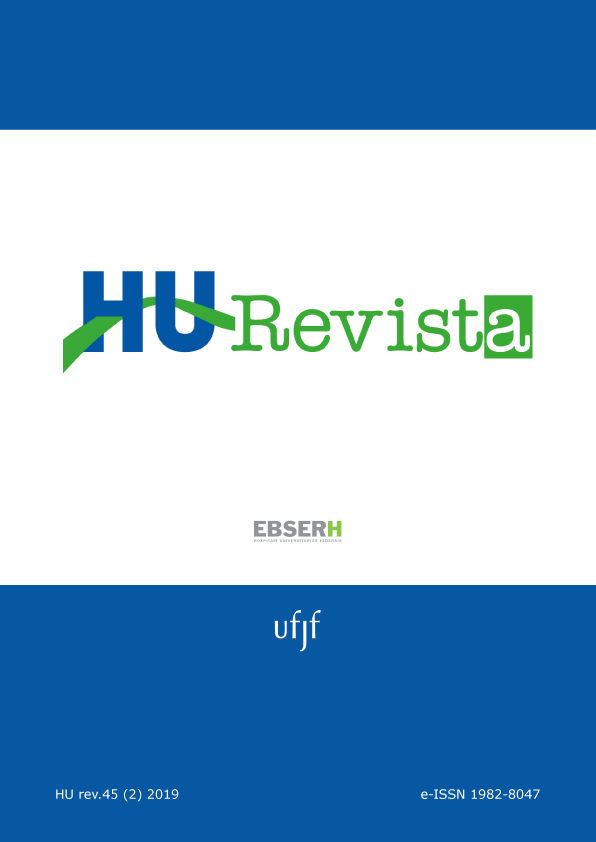Tomografia computadorizada de feixe cônico como método de avaliação da pneumatização da articulação temporomandibular
DOI:
https://doi.org/10.34019/1982-8047.2019.v45.27266Palabras clave:
Articulação Temporomandibular, Diagnóstico, Tomografia Computadorizada de Feixe CônicoResumen
Introdução: A pneumatização, considerada um processo fisiológico, são cavidades cheias de ar no interior dos ossos do crânio resultante de áreas de células epiteliais. Objetivo: Determinar a prevalência de pneumatização na fossa articular (PFA) e da eminência articular (PEA) do osso temporal por meio de exames de tomografia computadorizada de feixe cônico (TCFC). Material e métodos: Trezentas e noventa imagens de articulações temporomandibulares foram avaliadas por dois examinadores, devidamente calibrados, com experiência em imagens de TCFC. Nos casos em que foi detectada pneumatização, esta foi classificada de acordo com o tipo (unilocular e multilocular) e lateralidade (unilateral ou bilateral). Resultados: A PFA ou a PEA foi diagnosticada em 97 (49,74%) pacientes. Destes pacientes, 61 (31,3%) apresentaram PFA e 36 (18,5%) PEA. Em relação à lateralidade, na PFA, 36 (59%) apresentaram a condição unilateralmente e 25 (41%) bilateralmente. Dentre os pacientes com PEA, 24 (66,7%) apresentaram a condição unilateralmente e 12 (33,3%) bilateralmente. A pneumatização foi correlacionada entre os lados pelo coeficiente de correlação de Spearman e foi significativa para os casos multiloculares (fossa articular: rs=0,52 / p<0,0001 e eminência articular: rs=0,42 p<0,0001). Conclusão: A pneumatização da região temporomandibular é uma característica relativamente comum e, apesar de não necessitar de tratamento, a observação é fundamental para evitar complicações do tratamento ou diagnóstico errôneo na região.
Descargas
Citas
Ribeiro RC, Santos Jr BJ, Provenzano N, Freitas PH. Dautrey’s procedure: an alternative for the treatment of recurrent mandibular dislocation in patients with pneumatization of the articular eminence. Int J Oral Maxillofac. Surg. 2014; 43:465-69.
Burulday V, Akgül MH, Muluk NB, Ozveren MF, Kaya A. Evaluation of posterior clinoid process pneumatization by multidetector computed tomography. Neurosurg Rev. 2017; 40(3):403-9.
Khojastepour L, Paknahad M, Abdalipur V, Paknahad M. Prevalence and Characteristics of articular eminence pneumatization: a cone-beam computed tomographic study. J Maxillofac Oral Surg. 2018; 17(3):339-44.
Ilgüy M, Dölekoğlu S, Fisekçioğlu E, Ersan N, Ilgüy D. Evaluation of pneumatization in the articular eminence and roof of the glenoid fossa with cone-beam computed tomography. Balkan Med J. 2015; 32:64-8.
Khojastapour L, Mirbeigi S, Ezoddini F, Zeighami N. Pneumatized articular eminence and assessment of its prevalence and features on panoramic radiographs. J Dent Tehran Univ Med Sci. 2015; 12:235-42.
Shamshad MP, Kamath G, Babshet M, Srikanth HS, Doddamani L. Prevalence of temporal bone pneumatization in relation to temporomandibular joint: a computed tomographic study. J Stomatol Oral Maxillofac Surg. 2018; 119:118-21.
Sun WS, Beom CJ, Hojong K, Yesun C. Evaluation of temporal bone pneumatization with growth using 3D reconstructed image of computed tomography. Auris Nasus Larynx. 2017; 44:522-7.
Dexian AT, Hui Ng J, Lim SA, Low DYM, Yuen HW. Classification of temporal bone pneumatization on high-resolution computed tomography: prevalence patterns and implications. Otolaryngol Head Neck Surg. 2018; 159:743-9.
Nadaes MR, Melo LPL, Haiter Neto F, Freitas DQ. Correlation between temporomandibular joint temporal component pneumatization and morphology: analysis by cone beam computed tomography. Int J Oral Maxillofac Surg. 2018; 10:1-8.
Jadhav AB, Fellows D, Hand AR, Tadinada A, Lurie AG. Classification and volumetric analysis of temporal bone pneumatization using cone beam computed tomography. Oral Surg Oral Med Oral Pathol Oral Radiol. 2014; 117(3):376-84.
Chicarelli M, Batistussi França VT, Walewski LA, Iwaki LCV, Tolentino ES. Temporal bone pneumatization in patients with dentofacial deformities: cone beam computed tomography study. Int J Oral Maxillofac Surg. 2019; 29(19):31168-3.
Salemi F, Shokri A, Maleki FH, Farhadian M, Dashti G, Ostovarrad F et al. Effect of field of view on detection of condyle bone defects using cone beam computed tomography. J Craniofac Surg. 2016; 27(3):644-8.
Barbosa GLR, Nascimento MC, Ladeira DB, Bomtorim VV, da Cruz AD, Almeida SM. Accuracy of digital panoramic radiography in the diagnosis of temporal bone pneumatization: a study in vivo using cone-beam-computed tomography. J Craniomaxillofac Surg. 2014; 42(5):477-81.
Yavuz MS, Aras MH, Güngör H, Büyükkurt MC. Prevalence of the pneumatized articular eminence in the temporal bone. J Craniomaxillofac Surg. 2009; 37:137-39.
Patil K, Mahima VG, Malleshi SN, Srikanth HS. Prevalence of zygomatic air cell defect in adults: a retrospective panoramic radiographic analysis. Eur J Radiol. 2012; 81:957-59.
Shokri A, Noruzi-Gangachini M, Baharvand M, Mortazavi H. Prevalence and characteristics of pneumatized articular tubercle: first large series in Iranian people. Imaging Sci Dent. 2013; 43:283-87.
Peltonen LI, Anrnisalo AA, Käser Y, Kortesniemi MK, Robinson S, Suomalainen A et al. Cone-beam computed tomography: a new method for imaging of the temporal bone. Acta Radiol. 2009; 50:543-48.
Teymoortash A, Hamzei S, Murthum T, Eivazi B, Kureck I, Werner JA. Temporal bone imaging using digital volume tomography and computed tomography: a comparative cadaveric radiological study. Surg Radiol Anat. 2011; 33:123-28.
Penninger RT, Tavassolie TS, Carey JP. Cone-Beam volumetric tomography for applications in the temporal bone. Otol Neurotol. 2011; 32:453-60.
Barbosa GLR, Nascimento MCC, Ladeira DBS, Bomtorim VV, Cruz AD, Almeida SM. Accuracy of digital panoramic radiography in the diagnosis of temporal bone pneumatization: a study in vivo using cone-beam-computed tomography. J Craniomaxillofac Surg. 2013; 42:477-81.
Ezoddini F , Khojastepour L, Mirbeigi S, Zeighnami N. Pneumatized articular eminence and assessment of its prevalence and freatures on panoramic radiography. J Dent. 2015; 12:235-42.
Bhalchim SG, Jugade SC, Ramaswami E, Gogri AA, Kadam SG, Umarji HR. Prevalence of pneumatized articular tubercle using panoramic radiography and cone beam-computed tomography: a retrospective study. Contemp Clin Dent. 2018; 9(Suppl 2):S221-6.
Archivos adicionales
Publicado
Cómo citar
Número
Sección
Licencia
Cessão de Primeira Publicação à HU Revista
Os autores mantém todos os direitos autorais sobre a publicação, sem restrições, e concedem à HU Revista o direito de primeira publicação, com o trabalho licenciado sob a Licença Creative Commons Attribution que permite o compartilhamento irrestrito do trabalho, com reconhecimento da autoria e crédito pela citação de publicação inicial nesta revista, referenciando inclusive seu DOI.









